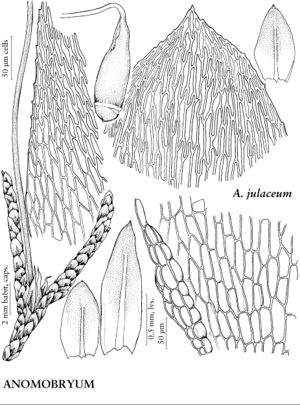Anomobryum julaceum
Syn. Musc. Eur., 382. 1860.
Stems strongly julaceous. Leaves loosely imbricate when dry, strongly concave, 0.6–1.2 mm; costa ending mid leaf or 2/3 leaf length, rarely percurrent; distal laminal cells elongate-vermicular, 60–100 µm, 8–10: 1, walls sinuate. Specialized asexual reproduction absent. Seta 2–3 cm. Capsule inclined to nodding, brown or redbrown, ovate-pyriform, 1–2 mm; peristome double; endostome basal membrane high, segments broadly perforated, cilia 1–3, appendiculate to nodose. Spores 8–13 µm.
Phenology: Capsules mature Jun–Sep.
Habitat: Acidic seepy or damp soil, soil over rock, ledges
Elevation: low to high elevations (0-4000 m)
Distribution

Greenland, Alta., B.C., N.W.T., Nunavut, Yukon, Alaska, Calif., Colo., Conn., Mich., Minn., N.Y., N.C., Pa., Wis., Mexico, Central America, South America, Eurasia, Africa, Subantarctic Islands
Discussion
Anomobryum julaceum is a widespread boreal-temperate species; capsules are very rare. Material from southern California and Mexico has been referred to var. mexicanum Schimper, but this variety is not recognized here.
Selected References
None.
Lower Taxa
"narrower" is not a number."narrow" is not a number.
